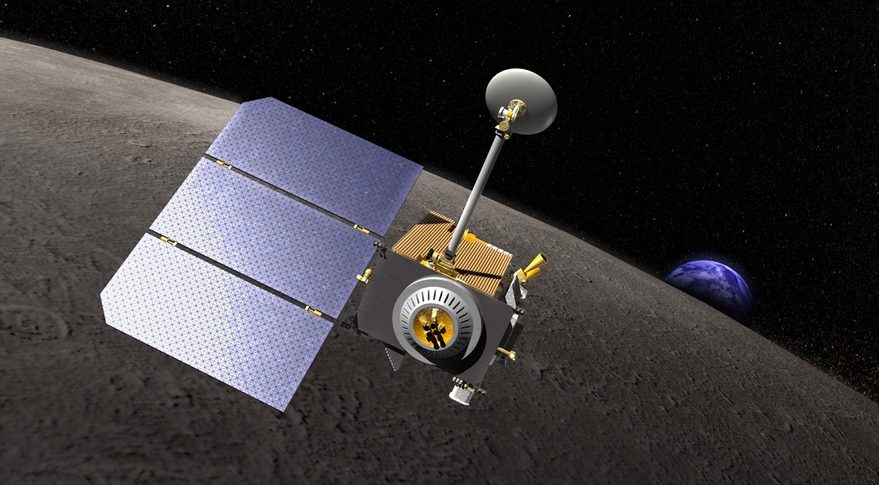NASA Lunar Orbiter Now Supporting Commercial and International Missions
WASHINGTON — A NASA spacecraft originally built as part of the previous effort to return humans to the moon is now playing a key role in the new effort at human lunar return, including aiding commercial landers.
One element of the Vision for Space Exploration, announced by President George W. Bush in 2004, was a series of robotic missions to the moon intended to start no later than 2008. The first such mission was an orbiter to collect high-resolution imagery of the lunar surface and other data to assist planning for future robotic and lunar lander missions.
That spacecraft, Lunar Reconnaissance Orbiter (LRO), eventually launched in 2009, even as the Obama administration was revisiting those broader lunar exploration plans. While the Vision for Space Exploration's lunar plans were ultimately cancelled, NASA continued to operate LRO as a science mission. [The Most Marvelous Moon Missions of All Time]
LRO remains operational today, and has about 20 kilograms of fuel left on board, Noah Petro, LRO project scientist, said at a meeting of the Lunar Exploration Analysis Group (LEAG) Nov. 15. "That may not seem like a lot, but we don't go through much fuel on an annual basis," he said, primarily to manage the spacecraft's momentum and make minor orbit adjustments.

Petro said that LRO will receive funding in fiscal year 2019 from the Commercial Lunar Payload Services (CLPS) program, where NASA will buy payload space on commercially developed landers. NASA announced Nov. 29 that it awarded contracts to nine companies working on such landers, although those companies will later have to compete for task orders to fly specific payloads, such as scientific instruments.
NASA is offering LRO to assist those future commercial landers. "The LRO team is standing ready to help," said Barbara Cohen, LRO associate project scientist, at the Nov. 29 announcement. That can include identifying sites close to potential resources or have high scientific value while also being safe locations for spacecraft landings.
That can include observations of the landing themselves. "We are working with some upcoming missions to try to pick landing dates that have favorable viewing geometries" that would allow LRO to observe the landings as they happen, she said. "We want to observe the plumes as the landers land and kick up dust and disturb the environment."
Get the Space.com Newsletter
Breaking space news, the latest updates on rocket launches, skywatching events and more!
LRO is also supporting other lunar missions outside of the CLPS program. At the LEAG meeting, John Keller, deputy project scientist for LRO, noted that the mission is helping international missions, including imaging sites for proposed future missions by Europe, India, Japan and Russia.
This includes two upcoming missions scheduled to attempt lunar landings next year. Keller said LRO is studying options of observing the landing of SpaceIL's lander, developed by an Israeli team that competed in the now-defunct Google Lunar X Prize, and India's Chandrayaan-2 lander, both targeting landings between March and May 2019.
For future commercial missions, Keller said that LRO planned to be "proactive" and reach out to the individual companies. "We will go out and say, 'Look, let us help you understand the LRO data set, how to use it and how it can it can help you be successful,'" he said. That could lead to discussions on how to further support those missions.
Notably absent from the discussions regarding LRO support of lunar missions is China, which launched its latest lunar lander, Chang'e-4, Dec. 7. American officials, including NASA Administrator Jim Bridenstine and National Space Council Executive Secretary Scott Pace, have left open the possibility of exchanging lunar scientific data with China. That could include, Pace noted at an October event, exchanges of samples should China succeed with planned robotic lunar sample return missions.
Pace, though, said there were challenges to such exchanges. He described discussions about efforts to use LRO to observe the impact of an unidentified Chinese spacecraft on the moon, including providing LRO orbital information to the Chinese in order to coordinate impact observations.
That impact, though, ultimately occurred without any notification of time or location by the Chinese, "much to the irritation of the U.S. scientists who spent a lot of time on this," Pace said. "This is not the way to build trust."
This story was provided by SpaceNews, dedicated to covering all aspects of the space industry.
Join our Space Forums to keep talking space on the latest missions, night sky and more! And if you have a news tip, correction or comment, let us know at: community@space.com.

Jeff Foust is a Senior Staff Writer at SpaceNews, a space industry news magazine and website, where he writes about space policy, commercial spaceflight and other aerospace industry topics. Jeff has a Ph.D. in planetary sciences from the Massachusetts Institute of Technology and earned a bachelor's degree in geophysics and planetary science from the California Institute of Technology. You can see Jeff's latest projects by following him on Twitter.










